Andy and Strato are being filmed! Good by to skiers!
Temperature: minus 24.9.5 C, minus 12.8 F Windchill: minus 33.6 C, minus 28.4 F Wind: 6 knts. Weather: bright and sunny in the morning, then increasing cloudy with little visibility
I started my Monday at 5:30 am to send more pictures and webinar information during the best satellite times.So, during the morning of this magnificent Monday at the South Pole, I was in the computer room. It was wonderful getting so much done. The computer room was packed during these satellite hours!
At noon Amy, Andy and I met for lunch and discussed our Monday stratospheric balloon launch. We had a visitor today: an Artist who wanted to film Andy conducting the launch. She is part of the NSF program: Artists and Writers on the ice. Her special interest is producing documentaries about climate changes. Her name is: Andrea Polli (apoli [at] hunter.cuny.edu ) You can find more information here at: http://www.andreapolli.com
Andy the balloon film star!
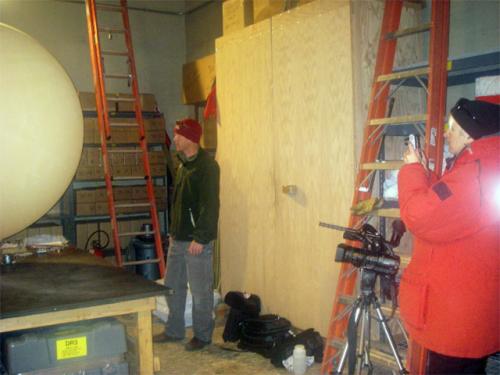 Andy inside the BIF filling the stratospheric balloon. Integrated media artist Andrea Polli is filming Andy.*
Andy inside the BIF filling the stratospheric balloon. Integrated media artist Andrea Polli is filming Andy.*
Andrea also recorded all the sounds of this procedure, including the sound of the balloon being filled and the sound the radiosonde makes when rising into the stratosphere which can be heard via our radio receiver in the BIF lab. I am glad that an artist is interested in climate changes and will promote the effort of the NOAA team.
**The strato balloon is being filmed **
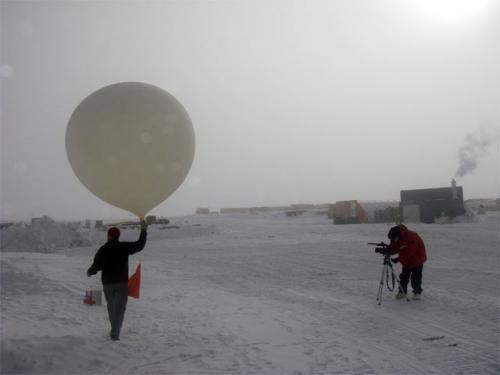 Andy is launching the balloon while Andrea Polli is filming him.*
Andy is launching the balloon while Andrea Polli is filming him.*
While the balloon was rising and the data was received in the lab, Amy and I continued to prepare two more ozone sondes for the next stratospheric flights conducted Mondays. These are some of the steps again that are needed to prepare the ozone sonde. Some of the steps need to be repeated just before launching, including changing the potassium iodine of the anode and cathode cell, running the sonde without and with ozone air, and taking the flow rate.
**Ozone sonde preparation
**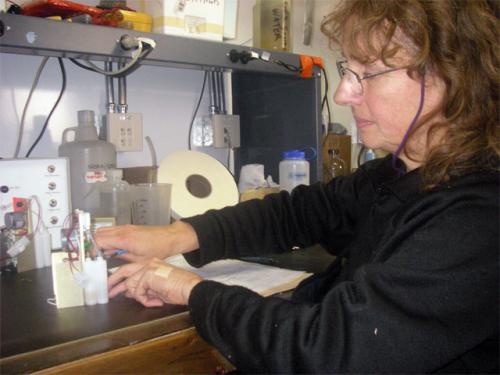 In order of changing the solution of the ozone sonde, the top of the cell has to be removed first.*
In order of changing the solution of the ozone sonde, the top of the cell has to be removed first.*
**Solution change
**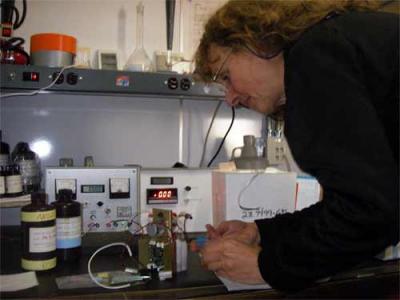 Elke is changing the solution of the anode and cathode cell with a syringe.*
Elke is changing the solution of the anode and cathode cell with a syringe.*
Once we were done the stratospheric flight was still in progress. So, Amy used the time to prepare for her class. She is teaching a course concerning personal finances. She will continue to do so throughout her stay in the winter. I used the time to continue writing some greetings on some of the 300 cards student gave me to send back from the South Pole! 200 more to go!
We were done just before dinner and enjoyed the warm meal. I particularly liked the Italian vegetable soup!
After dinner I visited the ski team to say good by. The weather had changed dramatically and visibility was very low. Their return flight with a Twin Otter plane had been postponed several times. But suddenly it landed on the ski-way and taxied over to the tent! I do not know how these pilots fly in such low visibility.
**Twin Otter plane pick up.
**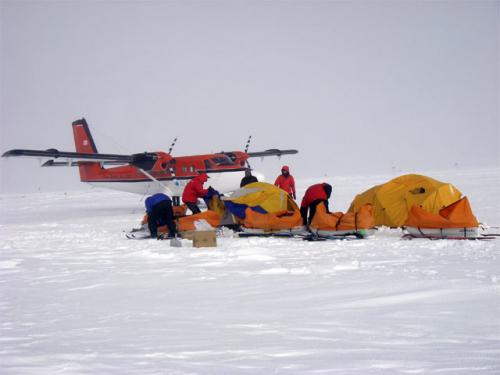 The twin Otter plane parked near the tents. The skier packed up their gear.*
The twin Otter plane parked near the tents. The skier packed up their gear.*
Group photo with skiers
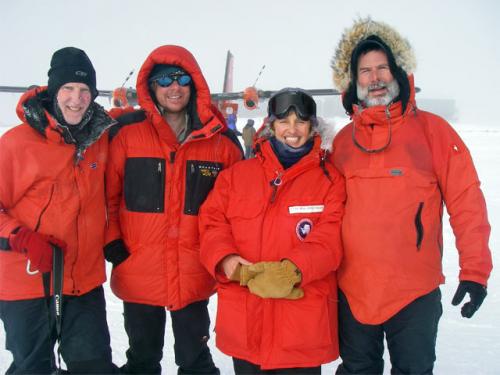 Goodbye to the skiers from Britain, Germany, Switzerland and Ireland.*
Goodbye to the skiers from Britain, Germany, Switzerland and Ireland.*
**Twin Otter gets fuel
**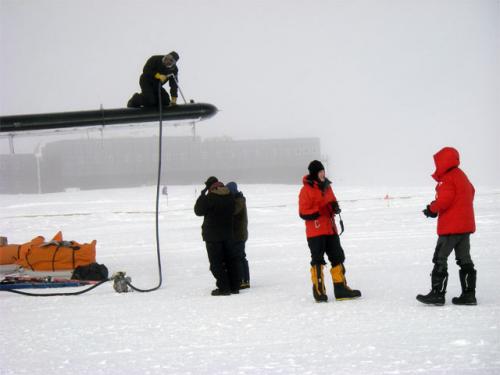 While the gear was packed, the Twin Otter was checked and received fuel. In the background one can see the New South Pole Station.*
While the gear was packed, the Twin Otter was checked and received fuel. In the background one can see the New South Pole Station.*
**Elke South Pole Station and Twin Otter
**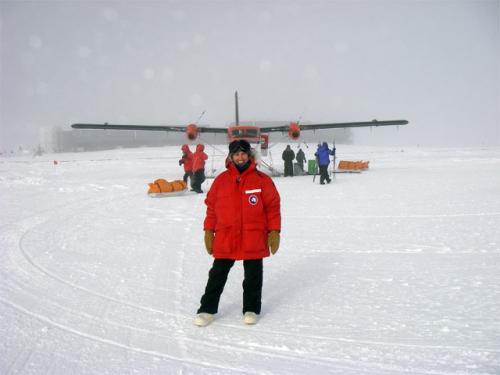 The weather has changed and the visibility is not so good. Elke stands here in front of a Twin Otter. The station is in the background.*
**The Twin Otter take off
**
The weather has changed and the visibility is not so good. Elke stands here in front of a Twin Otter. The station is in the background.*
**The Twin Otter take off
**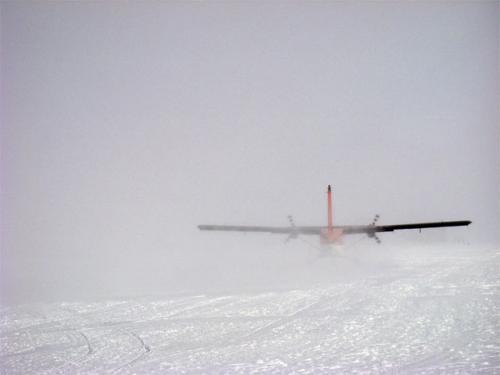 The Twin Otter is taxiing to the ski-way for take off.*
The Twin Otter is taxiing to the ski-way for take off.*
Twin Otter planes are considered the "work-horses" of the Antarctic and Arctic. Many research teams are using such planes to fly to remote station across Antarctica, including a seismology team from the South Pole.
South Pole station is a busy place. Many researchers are passing through to get their work done during the summer season. I have seen two planes here parked at the Station, including the Twin Otter plane, and I will try to find out more about their passengers! So, stay tuned!
**Planes parked at South Pole Station
**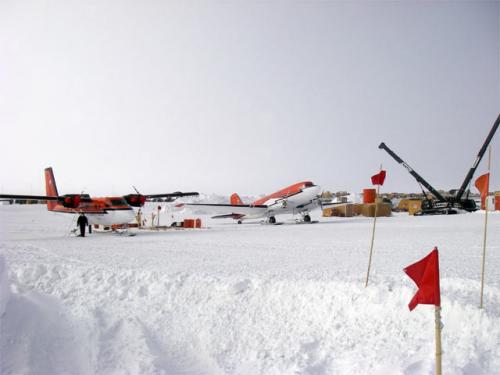 Here are two planes parked at South Pole station near the cargo area. They are used to bring researchers to remote areas.*
Here are two planes parked at South Pole station near the cargo area. They are used to bring researchers to remote areas.*
I have not told you yet that 3 days ago, workers at the station put up the first Christmas tree: this one is certainly a great example how to recycle old parts for a piece of art: our outside Christmas tree.
**Christmas tree next to the Geographic Pole
**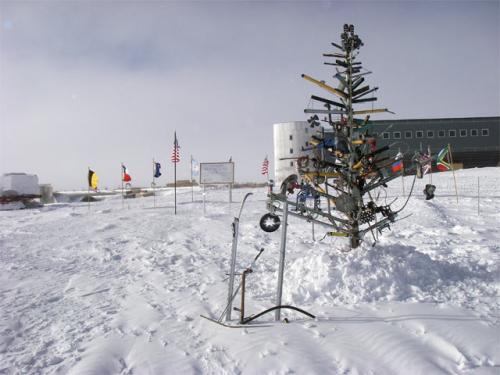 Every Christmas, this metal tree is put up next to Geographic.*
Every Christmas, this metal tree is put up next to Geographic.*
Christmas is coming and for all students and teachers the well deserved Christmas break.

